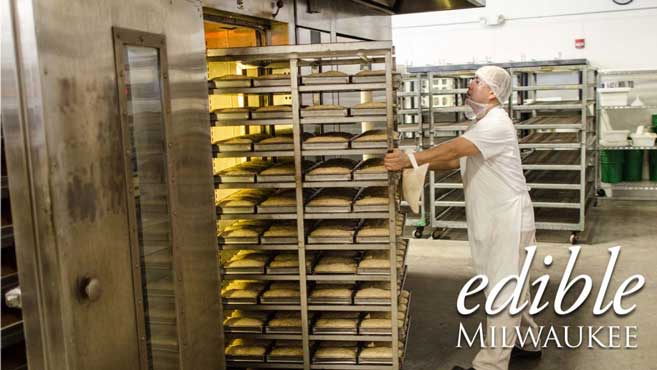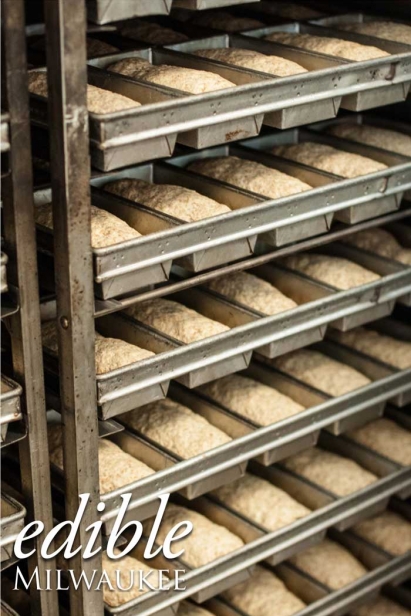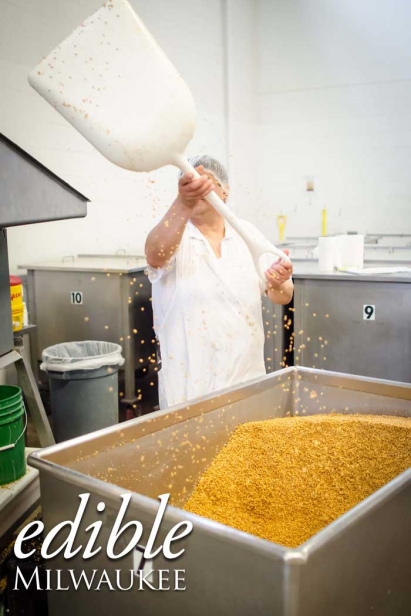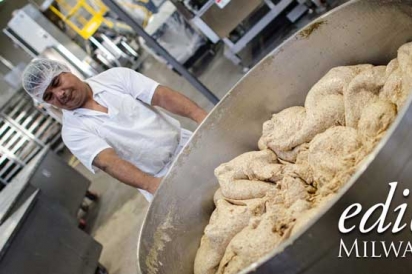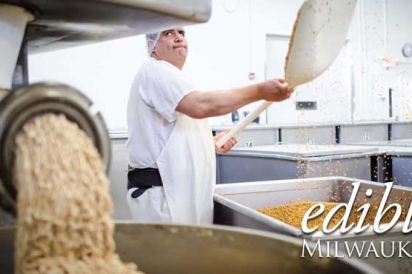Unprocessed: Breadbaking Sprouts From the Past Into the Future
James and Jenny Marino didn’t know their future lay in bread. But the “staff of life” became the driver of their new life in 2009, when they purchased a decades-old bakery in Waukesha.
“We got into bread very accidentally,” says Jenny Marino, CEO and president of Angelic Bakehouse. “We needed to reinvent ourselves after the collapse of the housing market and ended up buying Cybros, a bakery that had been producing sprouted grain breads for decades.”
The Marinos knew nothing about breadmaking. James had worked in the mortgage industry and Jenny was a stay-at-home mom. The pair hoped to find a business to buy and wanted to stay in Milwaukee, but they initially dismissed Cybros, because sprouted grain was so far out of their comfort zone.
One night, over a dinner of turkey burgers, James flipped over the package of wheat buns that Jenny had purchased earlier that day. He loved the taste and wondered what made them different. The buns turned out to be sprouted. The baker? Cybros.
“The cliche of love at first bite is so true,” Jenny says, with a laugh.
The Marinos started learning everything they could about sprouted grains. They refined their recipes and started sourcing only nonGMO grain. In 2013, they rebranded Cybros as Angelic Bakehouse and moved into a larger facility in Cudahy to accommodate their tremendous growth.
“Our sales have gone up 50 percent each year,” Jenny says.
Angelic Bakehouse is part of a national explosion in the popularity of sprouted grains. Major food companies like Kellogg’s and restaurants like Panera Bread now feature sprouted grains in their products.
But sprouted grains aren’t some hipster or even hippie trend. The Sheboygan Press featured this health hint in its January 24, 1930 edition: “If you would improve your health, eat a few spoons full of sprouted grain every day… sprouted grain acts to improve the health.”
Sprouting has been common in other countries, including India and China, for centuries. In many cases, the food sprouted accidentally and the results were then adopted into the cuisine. And sprouted grain—often barley—is the essential ingredient in beer, a sprouted (or malted, as it’s known in beer parlance) product that Wisconsinites know quite well.
Almost every type of whole grain can be sprouted. What we think of as grains like rice, wheat and corn, are actually mature seeds, largely of cereal grasses. A whole grain has three edible parts crucial to creating a new plant: the inner germ, the starchy endosperm and the outer bran. Under the right conditions, these seeds can germinate into plants.
Sprouting involves several precise steps. Missteps in the growth and handling of sprouts can result in bacterial contamination, particularly in fresh uncooked sprouts like alfalfa. First, grains are steeped in warm water. The grains are then drained and kept in a warm and moist environment conducive to germination. Angelic Bakehouse uses a proprietary process to create its sprouted mash.
The Marinos purchase all their grain in bulk and do all their sprouting in house. Jenny says they try to source as locally as they can, buying most grain from the Midwest and Wisconsin when possible.
To make their products, the Marinos begin with a time- and temperature-controlled soak of seven different whole grains. The ratio of grains is different for each product.
The germinated grains are then drained, rinsed and ground to produce a wet mash used to make bread. Other bakeries dry their grains before grinding them into flour that can be used like any other flour.
Jenny calls the sprouting process an art.
“It’s easy to mess up. Leave the grains too long and you get a bad taste and texture,” she says. “Over-sprouting can also diminish the nutrients.”
The advent of industrial steam-powered roller mills in the 19th century made it easier to separate the bran that made bread dark and the lipids in the wheat germ that could make flour go rancid faster. This made flour whiter, more shelf stable, and able to survive transport as the country grew larger.
It also made bread less nutritious. This didn’t go unnoticed. Cookbook author and domestic science pioneer, Sarah Tyson Rorer, contended in an advice column reprinted in the August 22, 1895 edition of the Milwaukee Journal that the American habit of eating white bread caused “many cases of falling or premature gray hair. Anything which impoverishes the blood will almost invariably impoverish the hair as well.”
In the British Medical Journal, physician Charles Edward Shell protested that the roller mill inflicted a “vital injury… on our national well-being…[the flour] lacks the proteins, fats, vitamins and mineral constituents present in the original grain, providing only an emasculated substitute which is not merely inefficient, but also directly harmful.”
But nutrition took a backseat to efficiency. By the late 19th century, the United States began to have enormous, centralized roller mills that processed grain faster and put local, often stone, mills out of business.
The issue was also food safety. As the number of food-borne illnesses grew around the turn of the 20th century, many Americans became interested in where their food came from. Unlike today, though, this attention led to the avoidance of local products.
In 1896, Milwaukee Health Commissioner Walter Kempster investigated every bakery in the city and found at least half in “such a condition that the product from them is unwholesome.” He found chicken roosts in the bake rooms, flour kept on damp and dirty floors, and bakeries doubling as sleeping quarters for employees.
“Some places where bread is made are breeding places for disease and sickness,” he proclaimed in his report to the Common Council.
For residents reading about his findings in the local newspaper, the best solution seemed spotless, white factory bread made by clean hands in a modern facility. Between 1890 and 1930, Americans transitioned almost completely from homemade bread to store bought, and from brown bread to white.
This began to change again in the late 1960s and 1970s with countercultural opposition to processed foods and corporate culture. Many Americans began to embrace whole grains. It was in this environment that Cybros originally opened in 1969 with its sprouted grain ethos.
The Marinos, for their part, are true believers in the superior health of their products. And Angelic Bakehouse has built a loyal customer base, particularly among those with allergies who appreciate their attention to the sourcing of their products and their allergen-friendly facility.
Angelic Bakehouse uses its sprouted mash in bread, buns, rolls, flatbread, wraps and bread crisps. New products often come from the needs of the Marinos’ own family.
“We selfishly began expanding to fit our own needs and to provide healthy foods for our kids,” Jenny explains.
Whole grains are the hottest trend in sliced bread. The Marinos attribute their success to the taste and approachability of their product.
“Doing something good can be delicious,” Jenny says.


